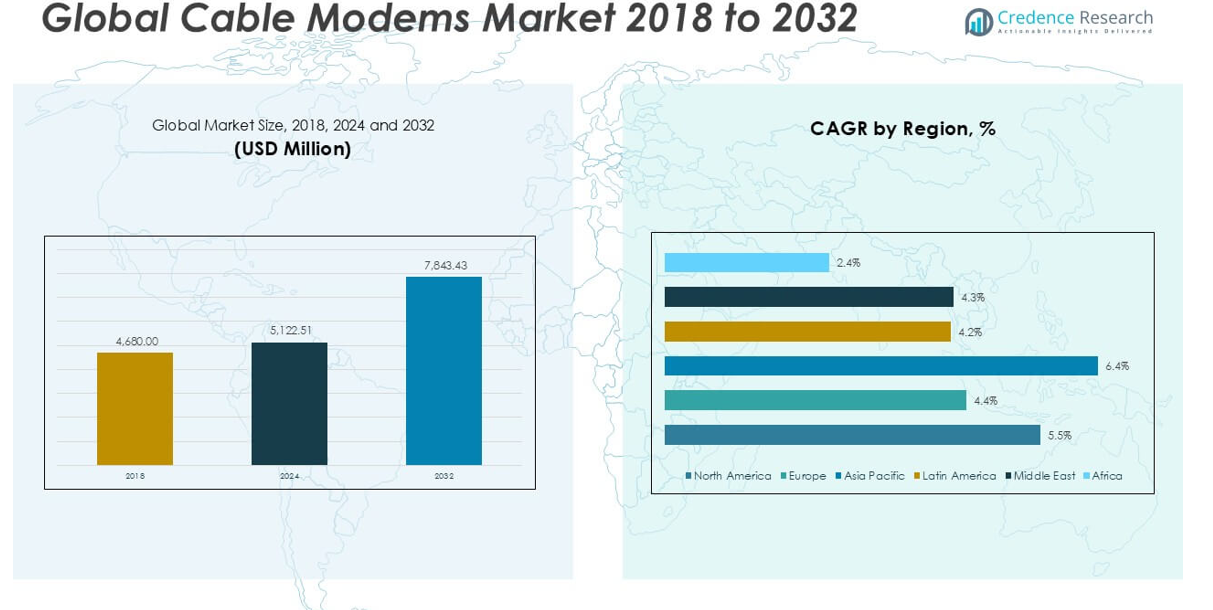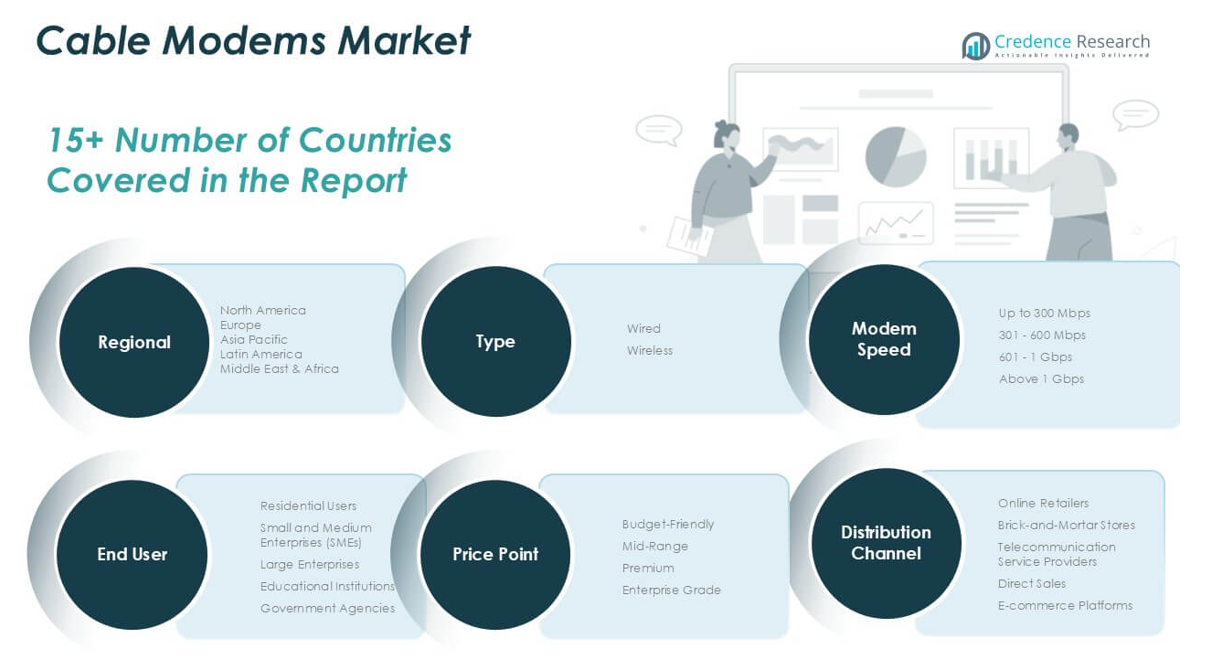CHAPTER NO. 1 : GENESIS OF THE MARKET
1.1 Market Prelude – Introduction & Scope
1.2 The Big Picture – Objectives & Vision
1.3 Strategic Edge – Unique Value Proposition
1.4 Stakeholder Compass – Key Beneficiaries
CHAPTER NO. 2 : EXECUTIVE LENS
2.1 Pulse of the Industry – Market Snapshot
2.2 Growth Arc – Revenue Projections (USD Million)
2.3. Premium Insights – Based on Primary Interviews
CHAPTER NO. 3 : CABLE MODEMS MARKET FORCES & INDUSTRY PULSE
3.1 Foundations of Change – Market Overview
3.2 Catalysts of Expansion – Key Market Drivers
3.2.1 Momentum Boosters – Growth Triggers
3.2.2 Innovation Fuel – Disruptive Technologies
3.3 Headwinds & Crosswinds – Market Restraints
3.3.1 Regulatory Tides – Compliance Challenges
3.3.2 Economic Frictions – Inflationary Pressures
3.4 Untapped Horizons – Growth Potential & Opportunities
3.5 Strategic Navigation – Industry Frameworks
3.5.1 Market Equilibrium – Porter’s Five Forces
3.5.2 Ecosystem Dynamics – Value Chain Analysis
3.5.3 Macro Forces – PESTEL Breakdown
3.6 Price Trend Analysis
3.6.1 Regional Price Trend
3.6.2 Price Trend by product
CHAPTER NO. 4 : KEY INVESTMENT EPICENTER
4.1 Regional Goldmines – High-Growth Geographies
4.2 Product Frontiers – Lucrative Product Categories
4.3 Modem Speed Sweet Spots – Emerging Demand Segments
CHAPTER NO. 5: REVENUE TRAJECTORY & WEALTH MAPPING
5.1 Momentum Metrics – Forecast & Growth Curves
5.2 Regional Revenue Footprint – Market Share Insights
5.3 Segmental Wealth Flow – Type & Modem Speed Revenue
CHAPTER NO. 6 : TRADE & COMMERCE ANALYSIS
6.1. Import Analysis by Region
6.1.1. Global Cable Modems Market Import Revenue By Region
6.2. Export Analysis by Region
6.2.1. Global Cable Modems Market Export Revenue By Region
CHAPTER NO. 7 : COMPETITION ANALYSIS
7.1. Company Market Share Analysis
7.1.1. Global Cable Modems Market: Company Market Share
7.2. Global Cable Modems Market Company Revenue Market Share
7.3. Strategic Developments
7.3.1. Acquisitions & Mergers
7.3.2. New Product Launch
7.3.3. Regional Expansion
7.4. Competitive Dashboard
7.5. Company Assessment Metrics, 2024
CHAPTER NO. 8 : CABLE MODEMS MARKET – BY TYPE SEGMENT ANALYSIS
8.1. Cable Modems Market Overview by Type Segment
8.1.1. Cable Modems Market Revenue Share By Type
8.2. Wired
8.3. Wireless
CHAPTER NO. 9 : CABLE MODEMS MARKET – BY MODEM SPEED SEGMENT ANALYSIS
9.1. Cable Modems Market Overview by Modem Speed Segment
9.1.1. Cable Modems Market Revenue Share By Modem Speed
9.2. Up to 300 Mbps
9.3. 301 – 600 Mbps
9.4. 601 – 1 Gbps
9.5. Above 1 Gbps
CHAPTER NO. 10 : CABLE MODEMS MARKET – BY PRICE POINT SEGMENT ANALYSIS
10.1. Cable Modems Market Overview by Price Point Segment
10.1.1. Cable Modems Market Revenue Share By Price Point
10.2. Budget-Friendly
10.3. Mid-Range
10.4. Premium
10.5. Enterprise Grade
CHAPTER NO. 11 : CABLE MODEMS MARKET – BY END USER SEGMENT ANALYSIS
11.1. Cable Modems Market Overview by End User Segment
11.1.1. Cable Modems Market Revenue Share By End User
11.2. Residential Users
11.3. Small and Medium Enterprises (SMEs)
11.4. Large Enterprises
11.5. Educational Institutions
11.6. Government Agencies
CHAPTER NO. 12 : CABLE MODEMS MARKET – BY DISTRIBUTION CHANNEL SEGMENT ANALYSIS
12.1. Cable Modems Market Overview by Distribution Channel Segment
12.1.1. Cable Modems Market Revenue Share By Distribution Channel
12.2. Online Retailers
12.3. Brick-and-Mortar Stores
12.4. Telecommunication Service Providers
12.5. Direct Sales
12.6. E-commerce Platforms
CHAPTER NO. 13 : CABLE MODEMS MARKET – REGIONAL ANALYSIS
13.1. Cable Modems Market Overview by Region Segment
13.1.1. Global Cable Modems Market Revenue Share By Region
13.1.2. Regions
13.1.3. Global Cable Modems Market Revenue By Region
13.1.4. Type
13.1.5. Global Cable Modems Market Revenue By Type
13.1.6. Modem Speed
13.1.7. Global Cable Modems Market Revenue By Modem Speed
13.1.8. Price Point
13.1.9. Global Cable Modems Market Revenue By Price Point
13.1.10. End User
13.1.12. Global Cable Modems Market Revenue By End User
13.1.13. Distribution Channel
13.1.14. Global Cable Modems Market Revenue By Distribution Channel
CHAPTER NO. 14 : NORTH AMERICA CABLE MODEMS MARKET – COUNTRY ANALYSIS
14.1. North America Cable Modems Market Overview by Country Segment
14.1.1. North America Cable Modems Market Revenue Share By Region
14.2. North America
14.2.1. North America Cable Modems Market Revenue By Country
14.2.2. Type
14.2.3. North America Cable Modems Market Revenue By Type
14.2.4. Modem Speed
14.2.5. North America Cable Modems Market Revenue By Modem Speed
14.2.6. Price Point
14.2.7. North America Cable Modems Market Revenue By Price Point
14.2.8. End User
14.2.9. North America Cable Modems Market Revenue By End User
14.2.10. Distribution Channel
14.2.11. North America Cable Modems Market Revenue By Distribution Channel
14.3. U.S.
14.4. Canada
14.5. Mexico
CHAPTER NO. 15 : EUROPE CABLE MODEMS MARKET – COUNTRY ANALYSIS
15.1. Europe Cable Modems Market Overview by Country Segment
15.1.1. Europe Cable Modems Market Revenue Share By Region
15.2. Europe
15.2.1. Europe Cable Modems Market Revenue By Country
15.2.2. Type
15.2.3. Europe Cable Modems Market Revenue By Type
15.2.4. Modem Speed
15.2.5. Europe Cable Modems Market Revenue By Modem Speed
15.2.6. Price Point
15.2.7. Europe Cable Modems Market Revenue By Price Point
15.2.8. End User
15.2.9. Europe Cable Modems Market Revenue By End User
15.2.10. Distribution Channel
15.2.11. Europe Cable Modems Market Revenue By Distribution Channel
15.3. UK
15.4. France
15.5. Germany
15.6. Italy
15.7. Spain
15.8. Russia
15.9. Rest of Europe
CHAPTER NO. 16 : ASIA PACIFIC CABLE MODEMS MARKET – COUNTRY ANALYSIS
16.1. Asia Pacific Cable Modems Market Overview by Country Segment
16.1.1. Asia Pacific Cable Modems Market Revenue Share By Region
16.2. Asia Pacific
16.2.1. Asia Pacific Cable Modems Market Revenue By Country
16.2.2. Type
16.2.3. Asia Pacific Cable Modems Market Revenue By Type
16.2.4. Modem Speed
16.2.5. Asia Pacific Cable Modems Market Revenue By Modem Speed
16.2.6. Price Point
16.2.7. Asia Pacific Cable Modems Market Revenue By Price Point
16.2.8. End User
16.2.9. Asia Pacific Cable Modems Market Revenue By End User
16.2.10. Distribution Channel
16.2.11. Asia Pacific Cable Modems Market Revenue By Distribution Channel
16.3. China
16.4. Japan
16.5. South Korea
16.6. India
16.7. Australia
16.8. Southeast Asia
16.9. Rest of Asia Pacific
CHAPTER NO. 17 : LATIN AMERICA CABLE MODEMS MARKET – COUNTRY ANALYSIS
17.1. Latin America Cable Modems Market Overview by Country Segment
17.1.1. Latin America Cable Modems Market Revenue Share By Region
17.2. Latin America
17.2.1. Latin America Cable Modems Market Revenue By Country
17.2.2. Type
17.2.3. Latin America Cable Modems Market Revenue By Type
17.2.4. Modem Speed
17.2.5. Latin America Cable Modems Market Revenue By Modem Speed
17.2.6. Price Point
17.2.7. Latin America Cable Modems Market Revenue By Price Point
17.2.8. End User
17.2.9. Latin America Cable Modems Market Revenue By End User
17.2.10. Distribution Channel
17.2.11. Latin America Cable Modems Market Revenue By Distribution Channel
17.3. Brazil
17.4. Argentina
17.5. Rest of Latin America
CHAPTER NO. 18 : MIDDLE EAST CABLE MODEMS MARKET – COUNTRY ANALYSIS
18.1. Middle East Cable Modems Market Overview by Country Segment
18.1.1. Middle East Cable Modems Market Revenue Share By Region
18.2. Middle East
18.2.1. Middle East Cable Modems Market Revenue By Country
18.2.2. Type
18.2.3. Middle East Cable Modems Market Revenue By Type
18.2.4. Modem Speed
18.2.5. Middle East Cable Modems Market Revenue By Modem Speed
18.2.6. Price Point
18.2.7. Middle East Cable Modems Market Revenue By Price Point
18.2.8. End User
18.2.9. Middle East Cable Modems Market Revenue By End User
18.2.10. Distribution Channel
18.2.11. Middle East Cable Modems Market Revenue By Distribution Channel
18.3. GCC Countries
18.4. Israel
18.5. Turkey
18.6. Rest of Middle East
CHAPTER NO. 19 : AFRICA CABLE MODEMS MARKET – COUNTRY ANALYSIS
19.1. Africa Cable Modems Market Overview by Country Segment
19.1.1. Africa Cable Modems Market Revenue Share By Region
19.2. Africa
19.2.1. Africa Cable Modems Market Revenue By Country
19.2.2. Type
19.2.3. Africa Cable Modems Market Revenue By Type
19.2.4. Modem Speed
19.2.5. Africa Cable Modems Market Revenue By Modem Speed
19.2.6. Price Point
19.2.7. Africa Cable Modems Market Revenue By Price Point
19.2.8. End User
19.2.9. Africa Cable Modems Market Revenue By End User
19.2.10. Distribution Channel
19.2.11. Africa Cable Modems Market Revenue By Distribution Channel
19.3. South Africa
19.4. Egypt
19.5. Rest of Africa
CHAPTER NO. 20 : COMPANY PROFILES
20.1. Arcadyan Technology Corporation
20.1.1. Company Overview
20.1.2. Product Portfolio
20.1.3. Financial Overview
20.1.4. Recent Developments
20.1.5. Growth Strategy
20.1.6. SWOT Analysis
20.2. ARRIS International Limited
20.3. Askey Computer Corporation
20.4. CastleNet Technology
20.5. Cisco Systems
20.6. D-Link Corporation
20.7. Lindsay Broadband
20.8. MTRLC LLC
20.9. NETGEAR
20.10. Technicolor
20.11. TP-Link Technologies
20.12. Zoom Telephonics
20.13. Casa Systems
20.14. Broadcom
20.15. C9 Networks
20.16. Vecima Networks
20.17. Teleste Corporation
20.18. UBee









